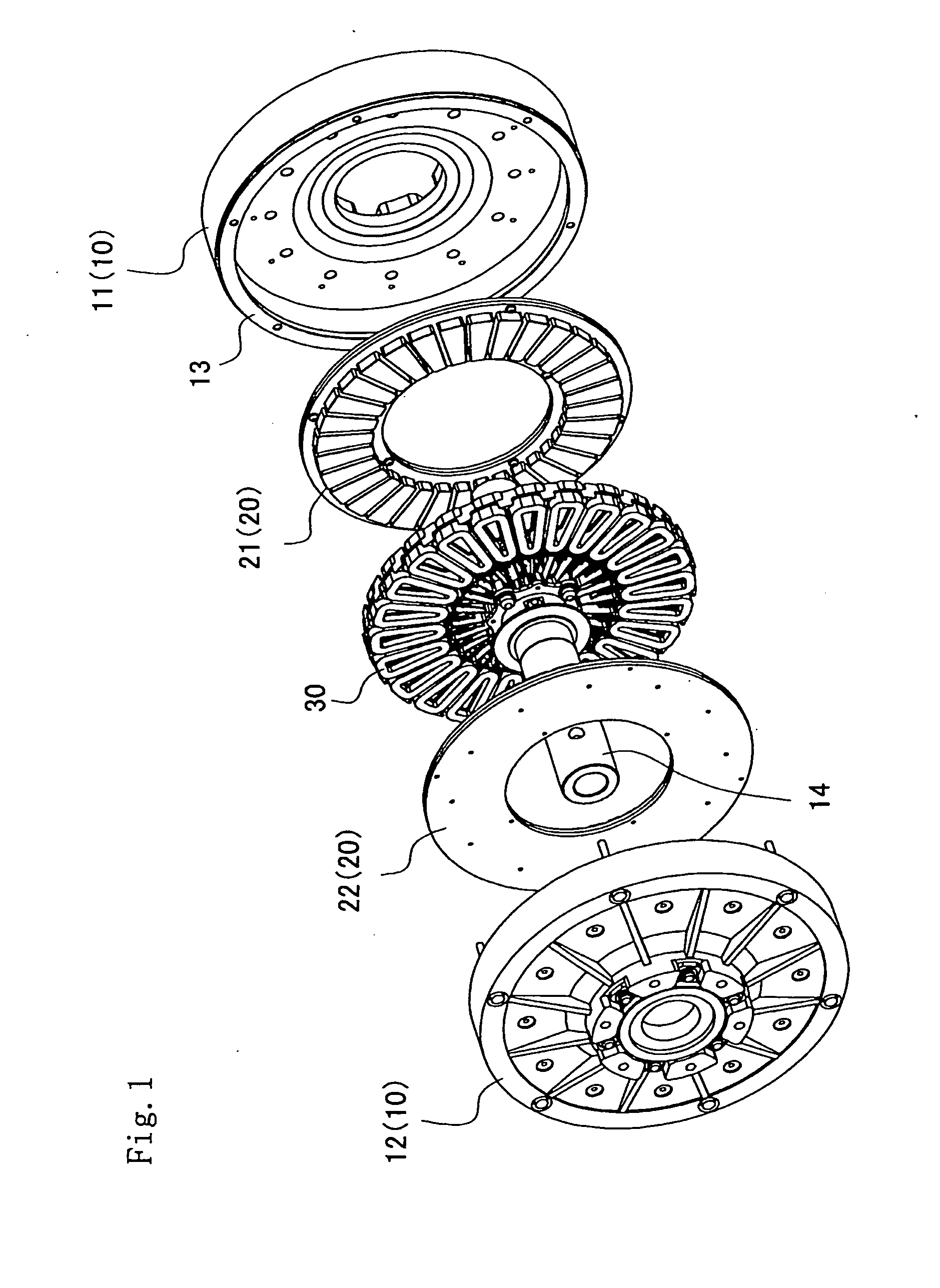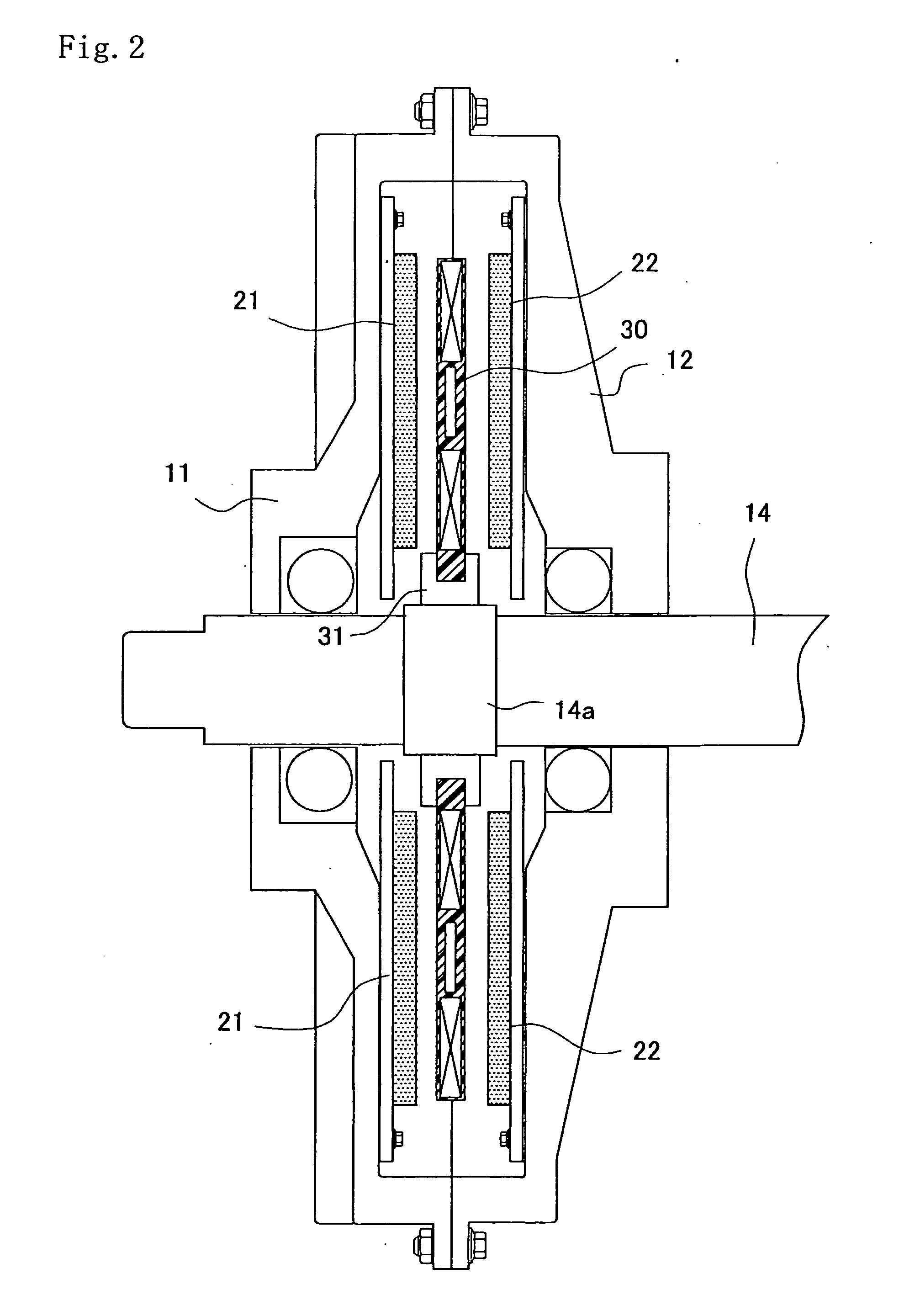Axial gap type rotating apparatus and axial gap type generator
a technology of axial gap and rotating apparatus, which is applied in the direction of rotating magnets, electrical apparatus, synchronous machines with stationary armatures, etc., can solve the problems of reducing the magnetic flux, increasing the reluctance, and affecting the effect of increasing output, so as to increase the magnetic flux passing across the coil, increase the output, and increase the magnetic flux. the effect of the coil
- Summary
- Abstract
- Description
- Claims
- Application Information
AI Technical Summary
Benefits of technology
Problems solved by technology
Method used
Image
Examples
embodiment 1
[0048]The Embodiment as shown in FIGS. 5A and 5B shows the case where the segment coils 32 are configured in one-layer structure. The pair of core yokes 21, 22 are spaced a distance d1 and located in the fixed shaft 14. In each of the core yokes 21, 22 are arranged magnet pieces 23x, 23y to form mutually opposed magnetic poles. In between the first and second core yokes 21, 22 are arranged the coil elements 32 fixed to the fixed shaft 14.
[0049]The magnet pieces 23x, 23y are spaced an air gap d1 to form opposed magnetic poles, and the coil elements 32 are disposed in the center (d1 / 2). In each of the coil elements 32, the yoke piece 33 is disposed in the non-winding portion 32Co of the core center while being in non-contact with the winding. The yoke piece 33 is spaced equal distances from the pair of core yokes (22).
[0050]As described previously, the magnet pieces 23x, 23y, coil elements 32 and yoke pieces 33 are arranged radially in the circumferential direction of the fixed shaft ...
embodiment 2
[0052]The Embodiment as shown in FIGS. 6A and 6B shows the case where the segment coils 32 are configured in two-layer structure. A first coil layer 32x and second coil layer 32y are arranged in the axial direction of the rotor shaft 14 in between the pair of core yokes 21, 22 configured as in above-mentioned Embodiment 1. The yoke piece 33x, 33y is arranged in the non-winding portion 32Co of each coil element. Then, in the first coil layer 32x and the second coil layer 32y is formed a phase difference with an offset amount δ in the rotation direction of the rotor. In other words, the first coil layer 32x and the second coil layer 32y are arranged as upper and lower layers in the axial direction of the rotor shaft, and are offset by a distance δ in the coil element of the first coil layer 32x and the coil element of the second coil layer 32y.
[0053]FIG. 6B shows the offset state, where the coil element (solid line in FIG. 6B) of the first coil layer 32x and the coil element (dashed ...
embodiment 3
[0054]The Embodiment as shown in FIGS. 7A and 7B is a modification of Embodiment 1 as shown in FIGS. 5A and 5B, and shows the case where the segment coils 32 are configured in two-layer structure as in the Embodiment in FIGS. 6A and 6B. In the Embodiment as shown in FIG. 7A, the yoke piece 33 is formed in the non-winding portion of each of the first coil layer 32x and the second coil layer 32y without any phase difference being formed. Meanwhile, in FIG. 7B, one yoke piece is disposed between the first coil layer 32x and the second coil layer 32y without any phase difference being formed. The other configuration is the same as in Embodiment 2 and is assigned the same reference numerals to omit descriptions.
[Output Property in Each Embodiment]
[0055]FIG. 8 shows the property of effective magnetic flux density of each Embodiment. In FIG. 8, the horizontal axis represents the position in the magnet, the dotted lines in the center show the center thereof, and the vertical axis represents...
PUM
 Login to View More
Login to View More Abstract
Description
Claims
Application Information
 Login to View More
Login to View More - R&D
- Intellectual Property
- Life Sciences
- Materials
- Tech Scout
- Unparalleled Data Quality
- Higher Quality Content
- 60% Fewer Hallucinations
Browse by: Latest US Patents, China's latest patents, Technical Efficacy Thesaurus, Application Domain, Technology Topic, Popular Technical Reports.
© 2025 PatSnap. All rights reserved.Legal|Privacy policy|Modern Slavery Act Transparency Statement|Sitemap|About US| Contact US: help@patsnap.com



